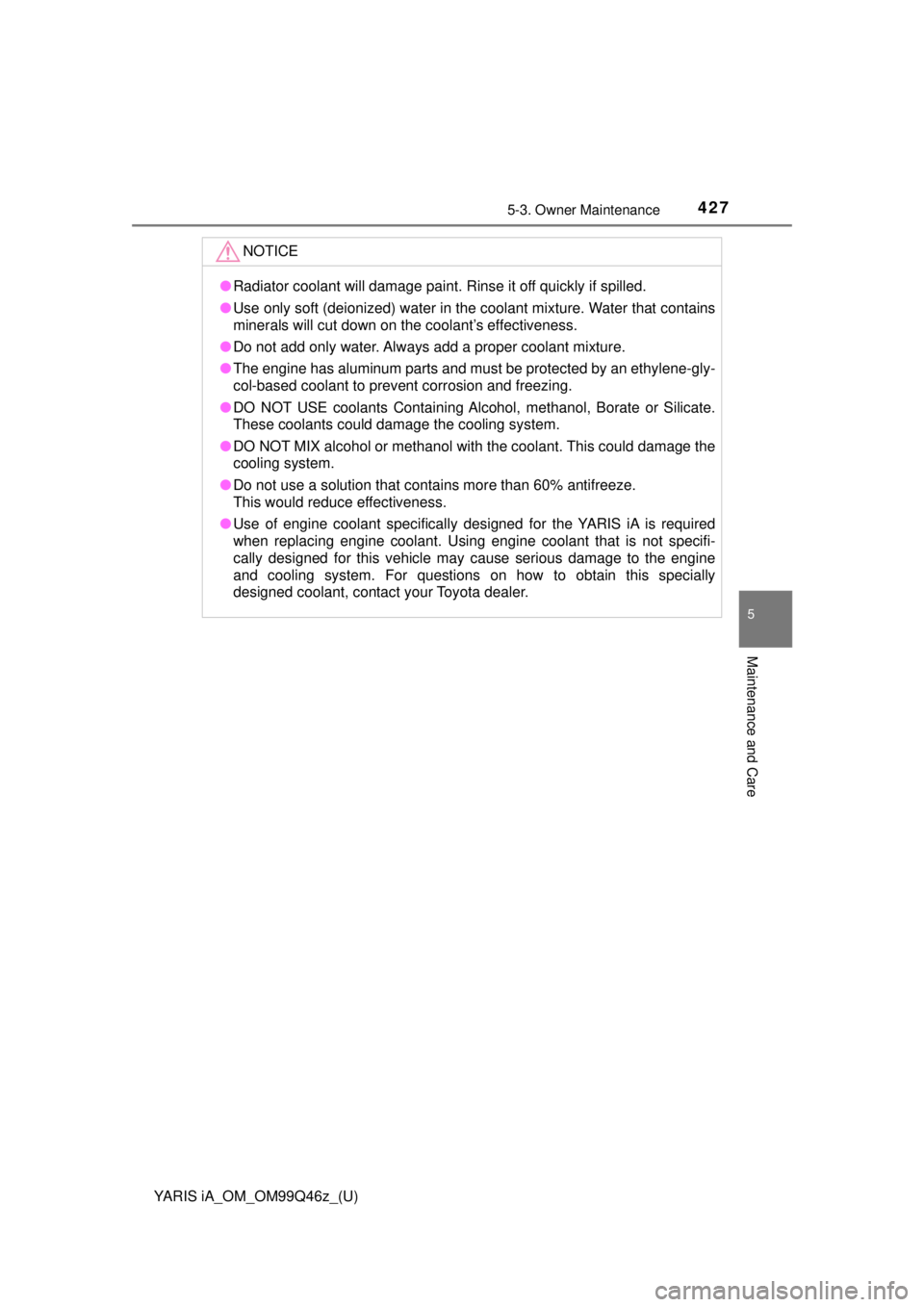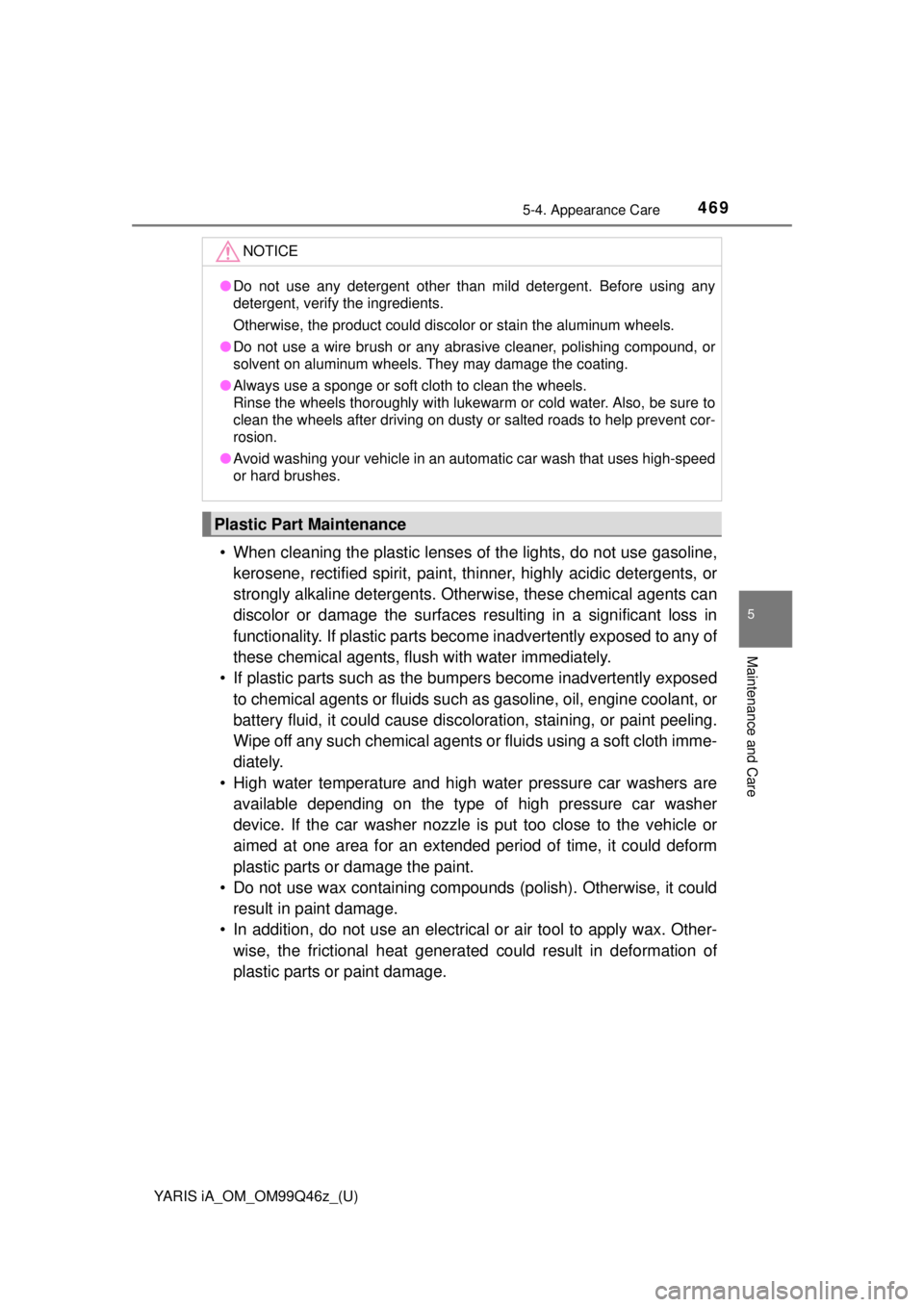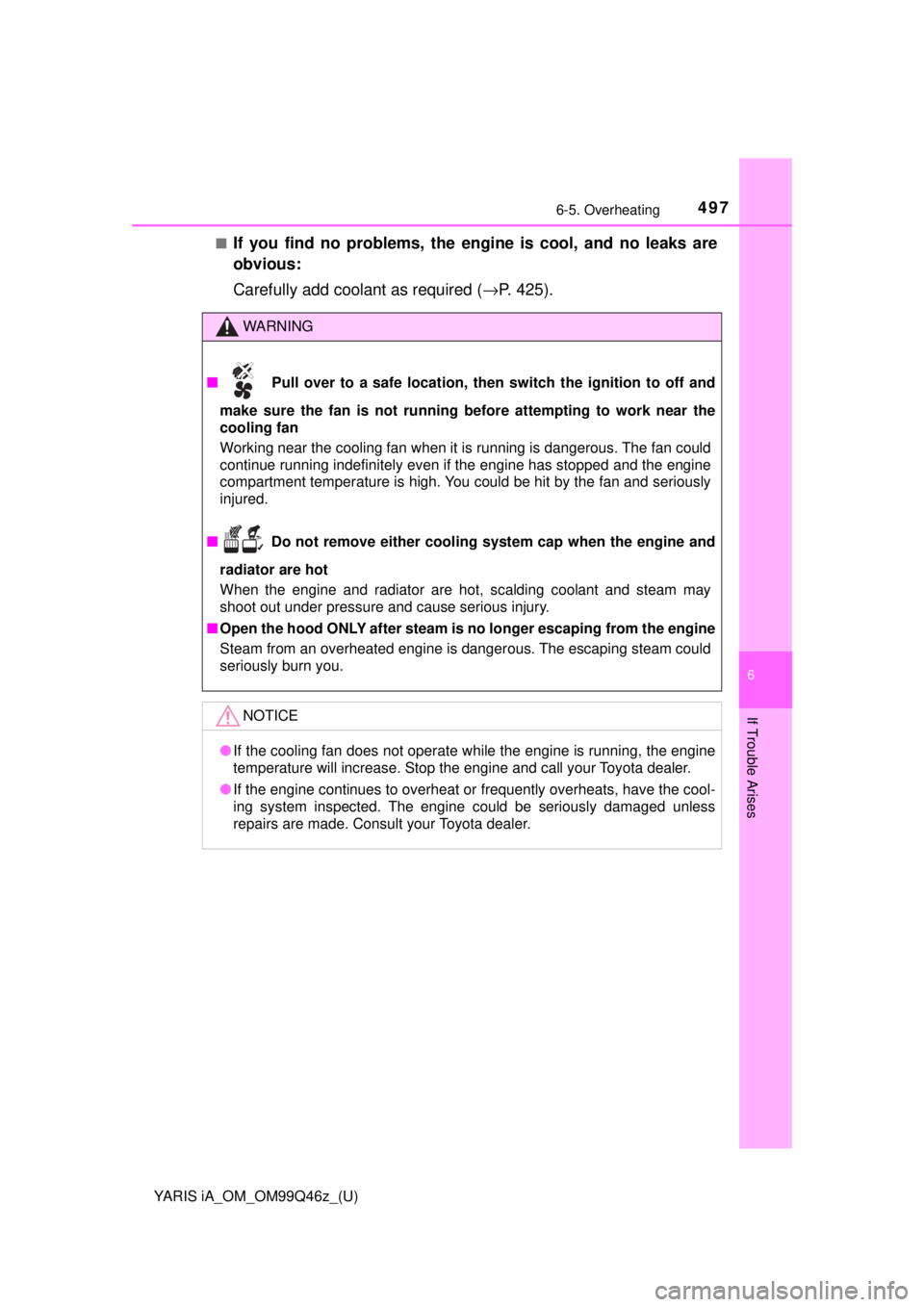Page 421 of 576
421
YARIS iA_OM_OM99Q46z_(U)
5-3. Owner Maintenance
5
Maintenance and Care
Engine Compartment Overview
Engine oil dipstick
Engine oil-filler cap
Brake/Clutch fluid reservoir
BatteryFuse block
Cooling system cap
Engine coolant reservoir
Windshield washer fluid reser-
voir1
2
3
4
5
6
7
8
Page 425 of 576

425
YARIS iA_OM_OM99Q46z_(U)
5-3. Owner Maintenance
5
Maintenance and Care
Engine Coolant
Inspect the antifreeze protection and coolant level in the coolant res-
ervoir at least once a year—at t he beginning of the winter season—
and before traveling where temperatures may drop below freezing.
Inspect the condition and connecti ons of all cooling system and
heater hoses.
Replace any that are swollen or deteriorated.
The coolant should be at full in the
radiator and between the F and L
marks on the coolant reservoir
when the engine is cool.
Cooling fan
Cooling system cap
Coolant reservoir
If it is at or near L, add enough coolant to the coolant reservoir to pro-
vide freezing and corrosion protecti on and to bring the level to F.
Securely tighten the coolant reserv oir tank cap after adding coolant.
If the coolant reservoir is empty or new coolant is required frequently,
consult your Toyota dealer.
Changing the coolant should be done by your Toyota dealer.
Inspecting Coolant Level
1
2
3
Page 426 of 576
4265-3. Owner Maintenance
YARIS iA_OM_OM99Q46z_(U)
WARNING
■Do not use a match or live flame in the engine compartment. DO NOT
ADD COOLANT WHEN THE ENGINE IS HOT
A hot engine is dangerous. If the engine has been running, parts of the
engine compartment can become very hot. You could be burned. Carefully
inspect the engine coolant in the coolant reservoir, but do not open it.
■ Pull over to a safe location, then switch the ignition to off and
make sure the fan is not running befo re attempting to work near the
cooling fan
Working near the cooling fan when it is running is dangerous. The fan could
continue running indefinitely even if the engine has stopped and the engine
compartment temperature is high. You could be hit by the fan and seriously
injured.
■ Do not remove either cooling system cap when the engine and
radiator are hot
When the engine and radiator are hot, scalding coolant and steam may
shoot out under pressure and cause serious injury.
Page 427 of 576

YARIS iA_OM_OM99Q46z_(U)
4275-3. Owner Maintenance
5
Maintenance and Care
NOTICE
●Radiator coolant will damage paint. Rinse it off quickly if spilled.
● Use only soft (deionized) water in the coolant mixture. Water that contains
minerals will cut down on the coolant’s effectiveness.
● Do not add only water. Always add a proper coolant mixture.
● The engine has aluminum parts and must be protected by an ethylene-gly-
col-based coolant to prevent corrosion and freezing.
● DO NOT USE coolants Containing Alcohol, methanol, Borate or Silicate.
These coolants could damage the cooling system.
● DO NOT MIX alcohol or methanol with the coolant. This could damage the
cooling system.
● Do not use a solution that contains more than 60% antifreeze.
This would reduce effectiveness.
● Use of engine coolant specifically designed for the YARIS iA is required
when replacing engine coolant. Using engine coolant that is not specifi-
cally designed for this vehicle may cause serious damage to the engine
and cooling system. For questions on how to obtain this specially
designed coolant, contact your Toyota dealer.
Page 469 of 576

YARIS iA_OM_OM99Q46z_(U)
4695-4. Appearance Care
5
Maintenance and Care
• When cleaning the plastic lenses of the lights, do not use gasoline,
kerosene, rectified spirit , paint, thinner, highly acidic detergents, or
strongly alkaline detergents. Other wise, these chemical agents can
discolor or damage the surfaces resulting in a significant loss in
functionality. If plastic parts beco me inadvertently exposed to any of
these chemical age nts, flush with water immediately.
• If plastic parts such as the bu mpers become inadvertently exposed
to chemical agents or fluids such as gasoline, oil, engine coolant, or
battery fluid, it could cause discoloration, stai ning, or paint peeling.
Wipe off any such chemical agents or fluids using a soft cloth imme-
diately.
• High water temperature and high water pressure car washers are available depending on the type of high pressure car washer
device. If the car washer nozzle is put too close to the vehicle or
aimed at one area for an extended period of time, it could deform
plastic parts or damage the paint.
• Do not use wax containing compounds (polish). Otherwise, it could
result in paint damage.
• In addition, do not use an electrical or air tool to apply wax. Other-
wise, the frictional heat generat ed could result in deformation of
plastic parts or paint damage.
NOTICE
● Do not use any detergent other than mild detergent. Before using any
detergent, verify the ingredients.
Otherwise, the product could discolor or stain the aluminum wheels.
● Do not use a wire brush or any abrasive cleaner, polishing compound, or
solvent on aluminum wheels. They may damage the coating.
● Always use a sponge or soft cloth to clean the wheels.
Rinse the wheels thoroughly with lukewarm or cold water. Also, be sure to
clean the wheels after driving on dusty or salted roads to help prevent cor-
rosion.
● Avoid washing your vehicle in an automatic car wash that uses high-speed
or hard brushes.
Plastic Part Maintenance
Page 496 of 576

496
YARIS iA_OM_OM99Q46z_(U)
6-5. Overheating
Overheating
If the high engine coolant temperature warning light turns on:Drive safely to the side of the road and park off the right-of-way.
Put a vehicle with an automatic tr ansaxle in park (P), a manual tran-
saxle in neutral.
Apply the parking brake.
Turn off the air conditioner.
Check whether coolant or steam is escaping from the engine com-
partment.
If steam is coming from the engine compartment
Do not go near the front of the vehicle. Stop the engine.
Wait until the steam dissipates, then open the hood and start the
engine.
If neither coolant nor steam is escaping
Open the hood and idle the engine until it cools.
Make sure the cooling fan is operating, then turn off the engine after
the temperature has decreased.
When cool, check the coolant level.
If it is low, look for coolant leaks from the radiator and hoses.
■If you find a leak or other damage , or if coolant is still leaking:
Stop the engine and call your Toyota dealer.
Cooling fan
Cooling system cap
Coolant reservoir
If the high engine coolant temperature warning light turns on,
the vehicle loses power, or you hear a loud knocking or pinging
noise, the engine is probably too hot.
1
2
3
4
5
6
7
1
2
3
Page 497 of 576

YARIS iA_OM_OM99Q46z_(U)
4976-5. Overheating
6
If Trouble Arises
■If you find no problems, the engine is cool, and no leaks are
obvious:
Carefully add coolant as required (→P. 425).
WARNING
■ Pull over to a safe location, then switch the ignition to off and
make sure the fan is not running befo re attempting to work near the
cooling fan
Working near the cooling fan when it is running is dangerous. The fan could
continue running indefinitely even if the engine has stopped and the engine
compartment temperature is high. You could be hit by the fan and seriously
injured.
■ Do not remove either cooling system cap when the engine and
radiator are hot
When the engine and radiator are hot, scalding coolant and steam may
shoot out under pressure and cause serious injury.
■ Open the hood ONLY after steam is no longer escaping from the engine
Steam from an overheated engine is dangerous. The escaping steam could
seriously burn you.
NOTICE
● If the cooling fan does not operate while the engine is running, the engine
temperature will increase. Stop the engine and call your Toyota dealer.
● If the engine continues to overheat or frequently overheats, have the cool-
ing system inspected. The engine could be seriously damaged unless
repairs are made. Consult your Toyota dealer.
Page 503 of 576

YARIS iA_OM_OM99Q46z_(U)
5036-7. Warning/Indicator Lights and Warning Sounds
6
If Trouble Arises
(Red)
High Engine Coolant Temperature Warning LightThe light flashes when the engine coolant temperature is
extremely high, and illuminates when the engine coolant
temperature increases further.
Handling Procedure:
• Flashing light
Drive slowly to reduce engine load until you can find a
safe place to stop the vehicle and wait for the engine to
cool down.
• Illuminated light This indicates the possibility of overheating. Park the
vehicle in a safe place immediately and stop the engine.
Refer to Overheating P. 496.
Power Steering Malfunction Indicator Light
The light illuminates/flashes if the electric power steering
has a malfunction.
If the light illuminates/flashes, stop the vehicle in a safe
place and do not operate the steering wheel. There is no
problem if the light turns off after a while. Contact your
Toyota dealer if the light illuminates/flashes continuously.
SignalWarning